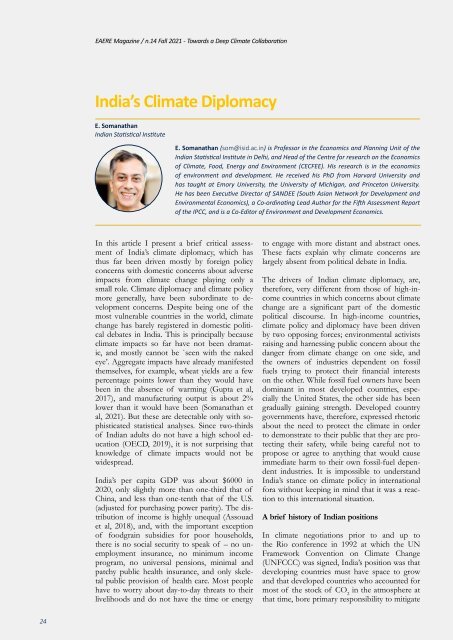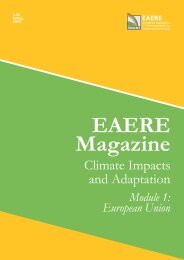EAERE Magazine - N.14 Fall 2021
Create successful ePaper yourself
Turn your PDF publications into a flip-book with our unique Google optimized e-Paper software.
<strong>EAERE</strong> <strong>Magazine</strong> / n.14 <strong>Fall</strong> <strong>2021</strong> - Towards a Deep Climate Collaboration<br />
India’s Climate Diplomacy<br />
E. Somanathan<br />
Indian Statistical Institute<br />
E. Somanathan (som@isid.ac.in) is Professor in the Economics and Planning Unit of the<br />
Indian Statistical Institute in Delhi, and Head of the Centre for research on the Economics<br />
of Climate, Food, Energy and Environment (CECFEE). His research is in the economics<br />
of environment and development. He received his PhD from Harvard University and<br />
has taught at Emory University, the University of Michigan, and Princeton University.<br />
He has been Executive Director of SANDEE (South Asian Network for Development and<br />
Environmental Economics), a Co-ordinating Lead Author for the Fifth Assessment Report<br />
of the IPCC, and is a Co-Editor of Environment and Development Economics.<br />
In this article I present a brief critical assessment<br />
of India’s climate diplomacy, which has<br />
thus far been driven mostly by foreign policy<br />
concerns with domestic concerns about adverse<br />
impacts from climate change playing only a<br />
small role. Climate diplomacy and climate policy<br />
more generally, have been subordinate to development<br />
concerns. Despite being one of the<br />
most vulnerable countries in the world, climate<br />
change has barely registered in domestic political<br />
debates in India. This is principally because<br />
climate impacts so far have not been dramatic,<br />
and mostly cannot be `seen with the naked<br />
eye’. Aggregate impacts have already manifested<br />
themselves, for example, wheat yields are a few<br />
percentage points lower than they would have<br />
been in the absence of warming (Gupta et al,<br />
2017), and manufacturing output is about 2%<br />
lower than it would have been (Somanathan et<br />
al, <strong>2021</strong>). But these are detectable only with sophisticated<br />
statistical analyses. Since two-thirds<br />
of Indian adults do not have a high school education<br />
(OECD, 2019), it is not surprising that<br />
knowledge of climate impacts would not be<br />
widespread.<br />
India’s per capita GDP was about $6000 in<br />
2020, only slightly more than one-third that of<br />
China, and less than one-tenth that of the U.S.<br />
(adjusted for purchasing power parity). The distribution<br />
of income is highly unequal (Assouad<br />
et al, 2018), and, with the important exception<br />
of foodgrain subsidies for poor households,<br />
there is no social security to speak of – no unemployment<br />
insurance, no minimum income<br />
program, no universal pensions, minimal and<br />
patchy public health insurance, and only skeletal<br />
public provision of health care. Most people<br />
have to worry about day-to-day threats to their<br />
livelihoods and do not have the time or energy<br />
to engage with more distant and abstract ones.<br />
These facts explain why climate concerns are<br />
largely absent from political debate in India.<br />
The drivers of Indian climate diplomacy, are,<br />
therefore, very different from those of high-income<br />
countries in which concerns about climate<br />
change are a significant part of the domestic<br />
political discourse. In high-income countries,<br />
climate policy and diplomacy have been driven<br />
by two opposing forces; environmental activists<br />
raising and harnessing public concern about the<br />
danger from climate change on one side, and<br />
the owners of industries dependent on fossil<br />
fuels trying to protect their financial interests<br />
on the other. While fossil fuel owners have been<br />
dominant in most developed countries, especially<br />
the United States, the other side has been<br />
gradually gaining strength. Developed country<br />
governments have, therefore, expressed rhetoric<br />
about the need to protect the climate in order<br />
to demonstrate to their public that they are protecting<br />
their safety, while being careful not to<br />
propose or agree to anything that would cause<br />
immediate harm to their own fossil-fuel dependent<br />
industries. It is impossible to understand<br />
India’s stance on climate policy in international<br />
fora without keeping in mind that it was a reaction<br />
to this international situation.<br />
A brief history of Indian positions<br />
In climate negotiations prior to and up to<br />
the Rio conference in 1992 at which the UN<br />
Framework Convention on Climate Change<br />
(UNFCCC) was signed, India’s position was that<br />
developing countries must have space to grow<br />
and that developed countries who accounted for<br />
most of the stock of CO 2<br />
in the atmosphere at<br />
that time, bore primary responsibility to mitigate<br />
24













